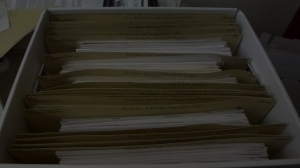It’s difficult to write summarily about a project that we’ve worked on for four years. As mentioned in Susan’s post, through working with these materials, we’ve lived with and thought about this organization and the people that built it for a long time now. Below find an unofficial timeline of some of the highlights of the project, as we wrap up our work with the UJA-Federation of New York collection.
Fall 2011: Project begins. The UJA-Federation of New York collection at this time contains over 3,200 bankers boxes of records from approximately 1909 to 2000 — in varying preservation condition– stored in the Citistorage warehouse in Brooklyn. Project staff includes Senior Archivist Susan Woodland, and AJHS Archivists Eric Fritzler, Marvin Rusinek, and Vital Zajka.
What does it mean to “process” a collection? In short, it means to arrange and describe a set of records. Archivists arrange the records in a clear order (this could be chronological, alphabetical, according to the order the records were received, or in some other way that makes sense for the particular records), and then describe this order and the content of the records in a finding aid to make the collection accessible for researchers.
The first step of an archival processing project is, usually, to survey the collection (archivists look through boxes and any existing documentation about the boxes—such as folder lists). This helps archivists to get a sense of the records and the ways in which they might be arranged, and develop a processing plan. Due to the nature of this unusually large collection, the archival team had to develop a processing plan without looking through all the boxes, and instead familiarized themselves with UJA-Federation of New York organizational history through reading secondary sources (see our Selected Bibliography) to inform their processing decisions, and to utilize material found within the collection itself to better understand people’s roles within the organization and the structure of the organization itself.
Processing initially began with the Oral History Project records, which we packed up at the UJA-Federation offices and worked with first, as this was a relatively small and distinct part of the collection.
December 2011: The first boxes arrive from the Citistorage warehouse, and processing begins on the rest of the collection. These boxes include some of the oldest records of the organization. The collection is split into four chronological subgroups: Federation of Jewish Philanthropies (FJP) 1909-1986, United Jewish Appeal (UJA) 1938-1986, UJA-Federation Joint Campaign (UFJC) 1973-1986, and UJA-Federation of New York (UJF) 1986-2000. The fifth subgroup, composed of UJA-Federation’s Oral History Project, has already been processed.
April 2013: Digitization of the Oral History Project is completed.
May 2013: Heather Halliday, former Photograph and Reference Archivist at the American Jewish Historical Society, joins the project.
December 2013: Processing of budget files from the Office of Management and Budget, the largest chunk of records in the collection (over 500 linear feet, or 5 football fields!), is completed. These files contain annual agency files, Budget Department subject files, financial reports, agency financial reports, audited agency reports, Distribution Committee reports, functional committee reports, Greater New York Fund files, and Financial Experience of Affiliated Societies files.
April 2014: Processing of UJF Executive Vice President files is completed. Over 167 linear feet, these files span UJF’s existence, from 1986-2000.
May 2014: Processing and digitization of Brooklyn Federation of Jewish Charities material, a precursor organization to FJP, is completed.
June 2014: A large selection of Board minutes from 1916-1992 are digitized.
Sept 2014: A preliminary finding aid for the FJP subgroup is completed, and the over 500 boxes described in this section are now available to researchers. With the completion of the project, this finding aid will be replaced with the full collection finding aid.
Oct 2014: Leah Edelman, newly minted archivist from the Simmons SLIS program, joins the project.
Jan 2015: A fire in the Citistorage warehouse destroys 123 out of 305 boxes remaining in storage. Fortunately, over 90% of the collection had already been removed from the warehouse, and processed.
June 2015: Nearly 500 images from the collection are digitized, dating from the 1910s through the 2000s.
July 2015: An online interactive map of Federation agencies goes live.
August 2015: With the completion of processing of oversize, artifact, and audiovisual materials (including the digitization of numerous sound recordings and films), processing of the UJA-Federation of New York collection is completed! The final box count is 2,021.
September 2015: During this final month, project staff is wrapping up last (but not small!) tasks, such as the completion of the finding aid and container list. We say goodbye on October 2!


















